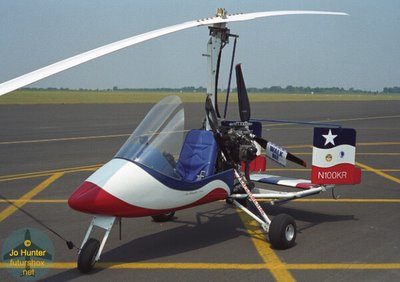Confession: The IFR Pilot thinks gyrocopters are pretty rad. Saw some at Oshkosh this year and was very intrigued with them. I'd consider building one, but my mechanical skills are probably a bit lacking. Though I did take a class with the IFR Pilot's Dad last year about building an RV. Maybe someday...
Here's a picture of this beautiful machine:NTSB Identification: DFW06LA028
14 CFR Part 91: General Aviation
Accident occurred Friday, November 11, 2005 in New Braunfels, TX
Aircraft: Rehler Gyrocopter, registration: N100KR
Injuries: 1 Fatal.
This is preliminary information, subject to change, and may contain errors. Any errors in this report will be corrected when the final report has been completed.
On November 11, 2005, at 1705 central standard time, an experimental Rehler gyrocopter, N100KR, was substantially damaged following a loss of control while on approach to Runway 13 at the New Braunfels Municipal Airport, near New Braunfels, Texas. The private pilot/builder/owner was fatally injured. Visual meteorological conditions prevailed and no flight plan was filed for the personal flight conducted under 14 Code of Federal Regulations Part 91.
Several witnesses observed the gyrocopter as it descended toward the runway. When the gyrocopter was about 30 feet above the runway, a gust of wind turned it sideways, and the gyrocopter flipped inverted and impacted the runway. Some of the witnesses reported hearing the engine make a power change before the impact.
A Federal Aviation Administration (FAA) inspector performed an on-scene examination of the wreckage. The inspector established flight control and engine continuity and found fuel in the fuel tanks. No mechanical deficiencies were noted.
Weather reported at the airport at 1751 was wind from 150 degrees at 12 knots, visibility 10 statute miles, broken clouds at 6,000 feet, overcast clouds at 7,000 feet, temperature 81 degrees Fahrenheit, dewpoint 62 degrees Fahrenheit, and a barometric pressure setting of 29.97 inches of Mercury.

The builder of this particular gyrocopter apparently had won numerous awards for this bird. You can read about it here.
From the report, it sounds like this was nothing more than a rouge gust of wind that wreaked havoc on the gyrocopter. Perhaps greybeard can enlighten us as to whether it's possible to recover from an inverted attitude in a rotorcraft...
My condolences to the pilot and his family. Remember to fly your aircraft all the way to the ground.
3 comments:
The answer to your question is: it depends, but probably not.
This machine has a rotor system on it comparable to most Bell helicopters.....the 47, Huey, and JetRanger.....what is commonly referred to as a semi-rigid system.
This rotor works perfectly, so long as the machine is experiencing "positive G's" of 1/2 "G" or more. The pilot puts in a control input......the rotor does what the pilot asks, the airframe then follows along.
You can compare this rotor system to a pail of water with a rope attached to the handle of the pail. You can control the pail with the rope fine, so long as you don't allow the rope to get slack in it. But move your hand quickly in a downward motion and throw slack in the rope, and you momentarily have no control over the pail.
When this pilot got inverted, he no doubt experienced zero or even negative G's. Under these circumstances, he had no control over his rotor. He was pretty much doomed.
I look forward to the final analysis of this accident. A capricious wind should not have had this effect on this machine.
Mechanical failure?
Extraordinary pilot error?
Let's keep an eye on this one.
Just reviewed your link to the pilot's construction. It appears the rotor may be fixed at a certain angle of attack, and the pilot may have controlled all axes of the aircraft with stabilizers.
If that is the case, my "pail of water" analogy may not apply.
Nevertheless, once he became inverted, his rotor wasn't providing useful lift, and he had precious little time to remedy his situation.
Upon further review of the owners site:
My initial conclusion was correct. It appears the rotor is used for pitch and roll control, and as such, would be a "semi-rigid" system on this machine.
If, as is reported, he got the machine inverted, he was doomed.......along for the ride. He would have had no pitch/roll control.
I am always concerned by builders that take it upon themselves to change the manufacturers design. In this case, he tweaked several parts of this machine, to include adding a spacer to the rotor system.
There is a reason the FAA requires these machines to display the "Experimental" placard......
Pilots that fly them truly are Test Pilots.
Those that make changes to the manufacturers design are also Aeronautical Engineers.
The pros get fooled sometimes.......
Amateurs are on really thin ice.
Post a Comment